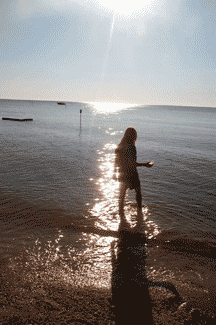 |
|||||||||||
|
|||||||||||
|
|||||||||||
Micro-Monsters Lurk in Chesapeake WatersBefore you go in the water, check the count
|
|||||||||||
 |
“High water temperatures and lots of nutrient-generated algae,” warns West/Rhode Riverkeeper Bob Gallagher, cause population explosions of swimming Vibrio vunlificus, which pass into your body through cuts or sores. |
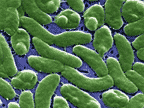 |
Tiny Invaders
Nearly 20 dangerous pathogens and bacteria can float alongside swimmers and boaters in the Bay, according to Maryland Department of the Environment. These villainous bacteria, protozoa and viruses can invade your body in three ways. First, swimming in contaminated water can expose you to bacteria like molluscum, that cause skin infections, and Pseudomonas aeruginosa, that causes swimmers ear.
Second, swallowing contaminants can cause bigger internal problems, like gastroenteritis, which causes fever, diarrhea and rashes. Eat raw shellfish, and you’re risking infection from Vibrio vunlificus.
“The most common illness you can get from swimming is diarrhea,” says physician Katherine Farrell, deputy health officer for Anne Arundel County. The causes are pathogens like norovirus, salmonella and shigella, polluting waters from sewage spills or even fecal reminants on humans or animals.
As well as the famed E. coli, health departments also worry about salmonella and shigell.
These species can only survive outside a body for 72 hours. That, explains Kerry Topovski, director of environmental health for Anne Arundel County, is why beaches close for two to three days after a sewage spill.
In the third kind of invasion microorganisms — like Mycobacterium marinum and Vibrio vunlificus — can seep in through cuts and scrapes, exacerbating the wound and swelling the point of attack, as happened to Merle Howard.
Mycobacterium marinum, part of the Bay’s ecosystem, makes its home in fresh or saltwater where, under higher temperatures, it crosses the coexistence threshold to cause infections in both fish and people.
This invader destroys tissue in fishes’ internal organs, such as the spleen and kidney, as well as making skin lesions. This spring and last summer, up to 60 percent of Bay rockfish are infestated.
Humans can contract Mycobacterium marinum — or one of nine other less-common strains — through direct contact with infected fish or water. The most frequent symptom, according to the Department of Natural Resources, is the formation of a persistent bump or nodule under the skin. The bacterium can also cause joint infections and swollen lymph nodes.
Cooking the bacterium kills it, so even infected rockfish are safe to eat — cooked thoroughly, not served as sashimi.
In Anne Arundel County, 11 people reported Mycobacterium marinum infection in 2005; five cases were reported in 2006.
Another of the most treacherous of the micro-monsters, Vibrio vunlificus, also flourishes in warm, salty waters.
“The consequences of Vibrio are much more serious,” says West/Rhode Riverkeeper Gallagher.
“It occurs naturally, but in much higher numbers when certain conditions exist like high water temperatures and lots of nutrient-generated algae.”
Swimming Vibrio passes from salty Bay or ocean waters into your body through cuts or sores.
But staying out of water doesn’t guarantee safety. Vibrio can pass into intestinal tract by way of contaminated seafood, such as raw or undercooked oysters.
In Anne Arundel County, Vibrio bacteria infected seven people in 2005 and six in 2006, causing gastrointestinal problems, ulcerations, near amputations and one death.
“The incidents in Maryland have increased in the last couple of years,” says Gallagher. With effects of global warming — increased rainfall and higher water temperatures — he expects more cases.
Though — other bacteria and viruses are more common, according to physician Katherine Farrell, deputy health officer for Anne Arundel County.
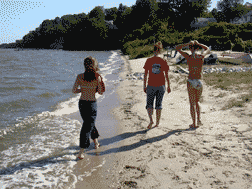 |
When water-borne bacteria counts climb too high, beachgoers are advised to stay out of the water. Many smaller, community beaches, like the one at Fairhaven Cliffs,, sample their own water in addition to county sampling. |
“The most common illness you can get from swimming is diarrhea,” Farrell says, which can come from pathogens like norovirus, salmonella and shigella. Even if there’s not a sewage spill, fecal reminants on humans or animals can wash off into the water.
One such bacteria — the famed E. coli — washes into waterways during sewage or fecal contamination. Health departments also worry about salmonella and shigella, also carried with warm-blooded animal waste when large amounts of warm-blooded animal or human waste enters the water.
“After a sewage spill — these species can only survive outside body for 72 hours,” says Kerry Topovski, director of environmental health for Anne Arundel County. That’s why the county closes beaches for two to three days after a sewage spill.
Most dangerous of them all are Vibrio and Mycobacterium.
Canary in the Mine
The number of potential pathogens is too vast to monitor individually, so indicator organisms are monitored to warn of bigger trouble in the water.
To keep an eye on bad bacteria, the Environmental Protection Agency — which writes the rules and measures for bacteria monitoring — advocates using enterococci, a relatively harmless group of bacteria that flourishes in warm-blooded animals. High counts mean fecal contamination and possibly E. coli and other illness-causing bacteria.
Enterocci is bacterium Anne Arundel tests for evidence of human waste,” says Elin Jones, spokeswoman for the health department, which has tested waters for bacteria since the late 1970s.
This bacteria has similar characteristics of more harmful strains, so it serves as the canary in the mine. If high counts of enterococci turn up in a water sample, more dangerous microbes like Vibrio strains are likely.
The highest allowable enterococci counts range from 100 to 158 colonies per 100 milliliters of water. But after a rainstorm with a surge of stormwater runoff, that number could skyrocket to 10,000 to 20,000 colonies, Gallagher says.
 |
For die-hard swimmers, shower after your swim, and wash with soap and warm water any scrapes or cuts. And always avoid swallowing Bay water if you’re in it. |
Tracking Microbes
From Memorial Day through Labor Day, the Anne Arundel County Department of Health monitors water from 103 county beaches — two are public — looking for the telltale enterococci.
The county samples and tests beach waters weekly, bi-weekly or monthly, depending on location, use, ecological factors, pollution sources and risk of contamination at each beach. Water samples might range from 10 — out of an allowable 35 at Sandy Point State Park on June 11, which is monitored weekly — to 348 out of an allowable 158 at Edna Road Beach in Rock Creek, which is monitored monthly.
Three water samples from each location are shipped to the Maryland state lab, where water tests reveal the amount of enterococci. The county averages the three results from each site. Each periodic report is posted by site on the website www.aahealth.org, where you’ll find any beach closings or advisories as well.
Calvert County tracks bacteria in a similar way at 11 beaches, posting results to the website earth911.org. Scroll down to Beaches911: Water Quality monitoring; then select Maryland and your county to find out a beach’s status. You won’t learn specific counts at the Calvert site, but you can find out if, for example, North Beach is closed — or has a warning — before you go. As this story went to print, Chesapeake Station next to Rod ’n’ Reel had an advisory; all other beaches were in the clear.
Maryland tests 225 beaches — 81 of those coastal — for bacteria. As results are posted by county, you won’t find a complete list at the Maryland Department of Environment website.
To help beachgoers make sense of bacteria numbers, the EPA has determined safety levels for open beaches, beach advisories — a strong recommendation to stay on dry land — and beach closings. At smaller beaches, you likely won’t see the status posted; you must check before you go to the beach.
As long as the sample shows a count lower than the EPA recommended level, typically in the 100s, swimmers can bathe at their own risk.
Recreational waters are in constant flux, so counts jump and fall like a Maryland thermometer. For instance, Fairhaven Beach dropped from 272 just before Memorial Day to 20 on June 13.
The only certainty is that rainwater that deluges the Bay — another reason to control our stormwater runoff — pours bacteria into our waters, and counts soar into the hundreds — or thousands. After a deluge, all Anne Arundel County beaches are officially closed — posted or not — and swimming forbidden for 48 hours.
“It’s important that people have the information and make a decision to take the risk,” says Riverkeeper Gallagher, who says he won’t enter the water with a cut. “Our job is to connect people to water. We don’t want to scare people away.”
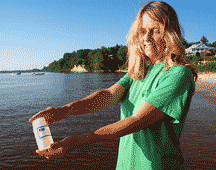 |
Sharon Brewer samples the water at Fairhaven Cliffs beach each week. |
Lost Beach Time
Bacteria spread their nasty reach far beyond Maryland. Congress passed the BEACH Act of 2000, requiring that coastal and Great Lakes states report beach warnings and closings.
“It’s not the best science in the world in terms of the methods that were used to identify the health risks,” says Topovski, Anne Arundel’s man on environmental health. “EPA based the water quality standards on surveys they did of people who were swimming at beaches and following up with them to see if anyone became ill.”
In the 2006 swimming season, all 30 coastal states — with a total 3,771 beaches — reported their bacteria findings to EPA. Of those, 1,201 beaches, nearly one-third, reported at least one advisory or closing. So bacteria kept swimmers out of ocean and Great Lakes waters some five percent of beach season.
In Chesapeake Country, our lost beach time was about the same. Last summer, Anne Arundel County posted five notifications and Calvert County posted seven. So far this year, no closings have been posted in either county.
Anne Arundel County residents can subscribe to email alerts about advisories and closings (www.aahealth.org/wqemail.asp).
Before you head to a Bay beach, check that it’s open to safe swimming.
Cause for Local Concern
For some communities, the county’s testing schedule and system isn’t enough.
Locales that get tested less — because fewer people use beaches — have a higher allowable number of bacteria.
“That’s a concept that I don’t agree with,” says West/Rhode Riverkeeper Gallagher. “If it’s dangerous for a lot of people, it’s dangerous for one person.”
Last year, Gallagher and a crew of volunteers began testing to cover 24 spots that the county wasn’t testing at all or testing every week, including the West River United Methodist Center, which is used as a camp.
Riverkeepers like Gallagher train and commission volunteers to gather their communities’ own quarter-liter samples to submit to the Anne Arundel Community College, where biology and environmental professor Dr. Sally Hornor counts bacteria. Hornor pours the samples through a filter that traps bacteria, incubates and counts under microscope.
South Riverkeeper Drew Koslow runs a similar testing program, though he tests only 10 sites and does all the sampling himself before sending in to Sally Hornor at the college.
“We try to let people in the community know the bacteria count results,” Koslow says. “I have a big distribution list, and regardless of results, I try to let them know what we found — whether just for peace of mind or if the counts are high.” Get on Koslow’s South River distribution list by emailing [email protected].
In May, after meeting with local riverkeepers, Advocates for Herring Bay began testing their waters at three sites.
“We formed based on the common sense that instead of relying on government to solve our environmental problems, we need to do something ourselves,” says Kathy Gramp, Herring Bay president. “We’re not trying to dispute what [the county’s] doing. We’re just trying to get a more complete profile.”
To afford the testing — $14 per sample at Sally Hornor’s community college lab — the Herring Bay Group asked neighbors to donate money to fund testing that would cost the small community thousands of dollars.
Those severe Vibrio cases farther north in West and Rhode rivers sparked the Advocates to action.
“After last year, after people got sick, that just heightened everyone’s awareness and we wanted to know about this bacteria,” Gramp says. “Testing once a month may not give you a clue.”
Since May 23, volunteer Brewer has sampled water at five locations and driven them to Anne Arundel Community College for bacteria counting.
“Most of the time our water’s fine. But it isn’t always,” Gramp says. “We want to know so folks that live and play in the water know what they should watch out for.” (Read this summer’s weekly findings at http://home.comcast.net/~herringbay/herringbay/waterquality.html)
The group has already seen startling results, Gramp reports. A high bacteria count — 272 — for Fairhaven beach came just days before Memorial Day weekend, when dozens of beachgoers played in and near the water. Neighbors informally spread news of the high bacteria counts. Swimmers still ventured in that sunny weekend, when the Bay could have flushed away the bacteria — or not.
“We’re learning our water quality fluctuates,” Gramp says. Plus, she notes, “we need to figure out where the bacteria is coming from and how to solve the [bacterial] problems.”
Rockhold Creek and Tracys Creek, which form Deale’s active boating harbor, empty into Herring Bay. Both have been long recognized by the state as having large bacteria counts.
“As a group, we’re concerned with the bacteria from a public health standpoint, but also the turbidity of the water and temperature affects grasses,” says Gramp, who considers the Bay more of a wading body of water than a swimming pool. “If there’s a problem of bacteria, we want to see what the problems are — dogs, septics or other — and work with our neighbors so we can make it better.”
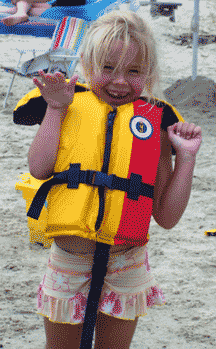 |
Like a life jacket, keeping tabs on beaches’ water quality makes sense. |
Staying Safe
“There’s always bacteria in natural water bodies. They are never completely risk free,” says Anne Arundel’s Topovski.
Stay safe when taking a dip in the Bay by showering both before and after your swim, advises the Anne Arundel County Health Department. At both the county’s public beaches — Sandy Point State Park and Mayo Beach — showers are on-site, as they are at North Beach in Calvert County.
“If you do have an open cut, we advise that people wash well with warm water and soap — and keep an eye for signs of infection,” Topovski says.
Avoid swallowing Bay water if you’re in it.
Avoid eating raw seafood.
Knowing your risk and using good judgment are your best protections, short of staying dry.
To keep animal and human waste out of the water, each of us living near waterways will need to take action. Our social responsibility to keep waste out of the water will keep us healthier.
First, boaters should always have their waste pumped out instead of dumping. Besides committing a crime, dumpers are risking everyone’s health. The first line of defense across Maryland is pumping stations. At the end of June The West/Rhode Riverkeeper program will begin operating a honey-dipper boat to pump out boats’ waste for free, making safe disposal even easier.
“A gallon of sewage can pollute an enormous amount of water,” says Gallagher. That’s why a sewage spill — tens of thousands of gallons — keeps us out of the water altogether.
Homeowners can help keep waters safe by maintaining and upgrading septic systems. Pet owners can get in the habit of picking up their animals’ wastes.
Taking extra precautions to prevent waste from entering the water may save your life or your neighbors.
Your final line of defense is staying in the know. Know your risks and local bacteria counts, and microbe monsters don’t have to scare you away from the water.
“In a community like ours is people say, I’ve grown up here and I’ve always gone swimming here,” Gramp says. “But it’s not the same Bay as it was.”
|
Current Issue \\ Archives \\ Subscriptions \\ Clasified Advertising \\ Display Advertising |

